
2019 IMN Host of the Year Award Winners
2019 IMN Host of the Year - Kosciusko County IMN program
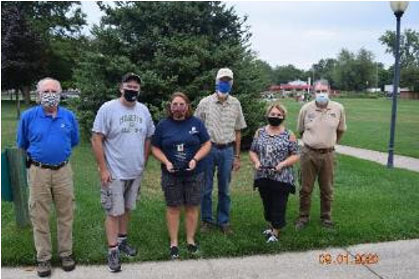 |
|
2019 Host of the Year award presentation. Pictured are Chuck Harvuot, State Council President (left) and Pardee Gunther, State Council member (right), presenting the Host of the Year Award to Darci Zolman, Director of the KCSWCD (2nd from right) and members of the Kosciusko County Soil and Water Conservation Board. |
The Kosciusko program is sponsored by the Kosciusko County Soil and Water Conservation District and directed by Darci Zolman. The classes are held in nine different locations over a nine-month period.
Each class subject includes a “lecture” but then the meeting moves outside to one of the amazing learning sites around the county. The venues include public lands (Pisgah Marsh boardwalk and Harrison School observatory), ACRES land trust property (Wildwood) and private lands donated by property owners including Koinonia (Manchester University), Grace College, a former tree farm and a restored peat mine/wetland habitat. Along with the fabulous natural locations, the presenters are vastly qualified and passionate about their topics.
The Kosciusko program is beginning its fifth year and have certified 36 IMN candidates and logged over 2,300 hours of volunteer service. The class size is limited to 20 participants and each year the program has been filled and has a waiting list.
KIMN has sponsored an alumni association since September 2017 offering educational programs to all interested on a quarterly basis. It has two of its Steering Committee members on the State Advisory Committee. Nominated by Jackie Horn
2019 IMN NEW Host of the Year – Marie Laudeman, Indiana Dunes State Park
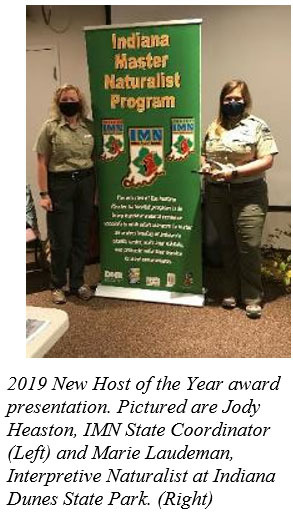
The 2019 IMN class held at the Indiana Dunes State Park had 26 area residents, from young adults to retirees, coming from a variety of backgrounds and experiences with the natural world. All participants verbalized a passion for nature and for continuing and expanding knowledge of Indiana’s geography, plants, water, soils and wildlife. Because the class was developed as a collaborative effort among a number of local organizations, participants were able to interact with a wider range of habitats and hands-on activities. These included collecting seeds, identifying rocks by testing their properties, and discussing the unique structure of a walking dune from its summit. Involved organizations included Humane Indiana, USGS, Indiana Native Plant Society, Great Lakes Research and Education Center, Audubon Society and the Indiana University Geology Department.
IMN host, Marie Laudeman, is already known in the park for her welcoming nature, her advocacy for the natural world and specifically for the park, and her extensive knowledge of the local flora and fauna. Her warm and welcoming demeanor made everyone feel at home right from the beginning of class. Her passion and enthusiasm for learning were contagious and contributed to a lively class atmosphere. Her organizational skills not only expanded the scope of the class as indicated above, but kept class expectations clear and provided additional expanded opportunities for participants to attend classes at alternative locations so no content would be missed.
Each speaker she scheduled was an expert in their field and provided not only knowledge, but their own brand of enthusiasm and motivation for continued learning. Marie motivated participants to get involved in other conservation organizations and to volunteer their time, and continues to let alumni know of local volunteer opportunities. Other conservation organizations have said they love IMN students as they were able to provide value right away.
Marie exemplifies what a true ambassador does to instill not only interest in and love of a subject, but a confident spirit for ongoing self-learning to every student. She is an appreciated member of the local community and an enthusiastic participant in educational programs for Indiana Dunes. She has successfully demonstrated her skills as a true ambassador for the Indiana Master Naturalist Program. Nominated by IMN Class 2019—Indiana Dunes State Park & Coffee Creek
|
2020 IMN Host of the Year Nominations needed
Each year the IMN Council awards an outstanding IMN Host/Site. Did you have an awesome IMN host? Was the IMN class you took great? Let us know. Please email your nomination with subject “2020 IMN Host of the Year nomination” to jheaston@dnr.IN.gov by February 1, 2021. Include the Host name and site where IMN classes were held, why you believe this person(s) deserves the award, and how they are great ambassadors for the IMN program. IMN Hosts—you are able to nominate yourself, too.
 One of the websites I follow is Journey North, a citizen science program founded in 1994 that tracks monarch butterflies and hummingbirds. Registered participants (over 60,000) can report sightings from the field, view maps from those reports, and leave comments. It’s an interesting and fun way for me to keep track of monarch migration, both north and south, during the year. Followers of butterfly migration know it happens mainly across North America. The southbound journey begins in September and October and they reach their roosting sites in central Mexico in November. Some fly as many as 3,000 miles to reach their destination.
I was reminded of that as I approached San Antonio, Texas on I-35 last week nearing the end of my 1,300-mile drive to visit my daughter, who lives just north of San Antonio. What prompted me to think of the Monarch migration was my encounter with hundreds of small butterflies along the highway. The American snout butterfly has been moving along the Interstate 35 corridor, clogging windshields and car grills along the way, for years. One would think that the number of butterflies that meet this end would cause concern, but experts say the population is so hardy, the vehicular traffic isn’t doing the population any damage.

The American snout, or common snout, butterfly (Libytheana carinenta) is a member of the subfamily Libytheinae in the brush-footed butterfly family and is found in both North and South America. Snout butterflies’ wings are patterned black and brown with white and orange markings. The forewings have a distinctive squared off, hook-like tip. They also have a prominent elongated mouthpart which helps give them the appearance of a dead leaf. Snouts often take advantage of this by hanging upside down under a twig, making them nearly invisible.
While this species is considered by some to be migratory, the snouts are actually opportunists, seeking their host plant and looking for mates. The migrations are more likely mass movements in and around central and south Texas following late summer rains, according to local biologists and butterfly enthusiasts. And, in some years they are so huge they can darken the sky.
Similar to the monarch’s dependence on milkweed, the snouts lay eggs on the leaves of hackberry trees. The drought-tolerant tree is often considered a trash shrub, (kind of like milkweed), but its leaves provide food for snout caterpillars and its berries offer important winter sustenance for birds. Large snout caterpillar populations can completely defoliate a hackberry tree, but the tree will recover. The caterpillars appear with a humped back, are dark green with yellow stripes along the top and sides of the body, and have two black tubercles on the top of the thorax. There can be hundreds of snout pupae hanging on every hackberry tree, and they can defoliate a hackberry tree- although the hackberry trees do recover.
The American snout nose butterfly isn’t threatened or endangered, like some other butterflies, because of the abundance of the spiny hackberry plant that they eat, and they are seen around this time of year in San Antonio, almost every year as they migrate down to the Rio Grande Valley. I find the similarities between the monarch and the snout quite interesting.
On a more IMN related note, please be reminded that the state council has adjusted the number of hours required for Advanced IMN status for 2020. You only need to complete 15 hours of volunteer activities and 4 hours of education. If you are uncertain about any of your hours, please contact Jody or me (crharvuot@gmail.com) for clarification. We are all hoping that 2021 will be more normal that 2020 has been, and we can each return to our typical volunteer activities.
Stay safe, your IMN Council President,
|


Accessible all-terrain wheelchairs added at Indiana Dunes SP
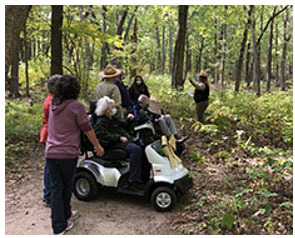
Three new all-terrain accessible wheelchairs were added for guest use at Indiana Dunes State Park during a donation ceremony recently. These chairs join a pool of several others available in Indiana State Parks to make trails more readily available to Hoosiers who need such assistance. These chairs for Indiana Dunes State Park were purchased by the Friends of Indiana Dunes, who were given discounted pricing from McCabe Outdoor Mobility. Two of the chairs are designed for use on trails, and one chair is designed for use on the beach.
In addition, donation funds in memory of Kevin O’Connell were used to clean, repair and provide new batteries for the park’s current X8 ATV Sand Chair that was donated by the Friends group several years ago. The event included a mobile hike with guests using the new chairs along a loop of trails 8 and 10 in the park. The Dunes ATV chairs will be located at the Nature Center from Labor Day through Memorial Day. Guests may reserve chairs by calling 219-926-1390. The chairs to use on the park’s beach can be borrowed through the lifeguards from Memorial Day weekend through Labor Day weekend.
Several other state parks offer guests motorized wheelchairs of varying types. Partners in the purchase of these chairs have included Innovation in Motion, the Emma Snyder Charitable Trust and the Indiana Natural Resources Foundation at Charlestown State Park; Indiana Trail 100 and Innovation in Motion at Chain O’Lakes State Park; the Brown family through the Friends of Spring Mill at Spring Mill State Park; the Friends of Mounds State Park and Auto Farm Mobility at Mounds State Park; Innovation in Motion at Pokagon, Fort Harrison and McCormick’s Creek state parks and the Harrison County Community Foundation at O’Bannon Woods State Park. For chair availability and additional information, contact the property you plan to visit.
|
O’Bannon Woods Valuable Couple
by Jarrett Manek, Interpretive Naturalist O’Bannon Woods
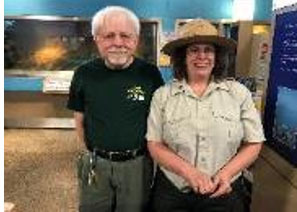
Two peas in a pod is how I would describe Chris and Bruce Fisher. The two go hand in hand. It has been really nice because it is a two-for-one deal, but they do work very differently and independently from each other, and from June of 2018 they both have been going strong without missing a beat.
I remember both of them vividly during our Harrison County Master Naturalist Course. They both had the passion to learn and when the opportunity presented itself for them to get their volunteer hours in, I was very pleased. Bruce had the desire to assist as a trail guide volunteer on the Wyandotte Cave tours while Chris favored the Nature Center. Most of the summer, underground is where Bruce spent his time with the cave guides while Chris focused on the operations of the diversity of the Nature Center and learned the ins and outs of the snakes, farmstead, field trips, and volunteers. She has taken on the role of volunteer coordinator with the multitudes of volunteers and hours that O'Bannon Woods State Park gets. From communications to number crunching, Chris has become the go-to person that the volunteers have learned to look to. When the hellbender exhibit came to life at the Nature Center in 2019, Bruce adopted them and moved from underground to aquatics! He has learned the system, fed, cleaned, run tests, changed out water, donated supplies, and much more. He has really adopted all the animals at the Nature Center from the hellbenders to the turtles and even the oxen, Forest and Gump. With special treats delivered and fed to all, he has become one of the animals' favorite faces.
In 2019, Bruce got the Park's volunteer highest hours honor with over 800 volunteer hours. Chris was not too far behind. This year, Bruce will be right in line with beating his record from last year. The two as a team have really contributed to not only a lot of volunteer hours and time, but have become some great fixture faces for the Nature Center and Park. They have set a great example for Nature Center Hosts, Master Naturalists, and volunteers across the board. Their dedication, love and devotion to the park has been far beyond what was expected from my first contact with them during an evening Master Naturalist Class on Snakes. They are very deserving of some recognition and thanks for giving back their time!
|
Black Vultures Moving their Range North
by Phil Cox, Ag & Natural Resources Extension Educator
Purdue University Cooperative Extension Service and IMN Council member
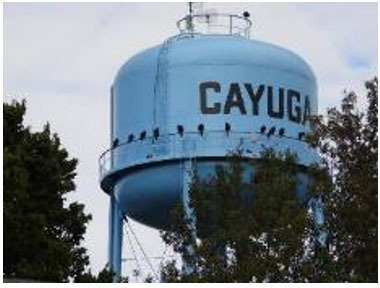
As scavengers, vultures play an important role in the ecosystem. Formerly suppressed by the effects of pesticides on reproduction, populations of both black and turkey vultures have increased dramatically in recent years. Vultures adapt and thrive in close proximity to people. They often form large roosts and loafing areas, numbering from a few dozen to hundreds of individual vultures. Population trends probably will continue to increase, as will the frequency of conflicts with people. In recent years, the west-central Indiana town of Cayuga, in northern Vermillion county, is now a favorite loafing area for hundreds of vultures (mostly black) including the fall of 2020. On certain heavy loafing days, these scavengers can be found loafing on the Cayuga water tower, homes, trees, harvested crop fields, round hay bales, etc.
Two species of vultures inhabit Indiana. The best-known species is the beneficial turkey vulture (Cathartes ayra). However, there is another species of vulture that is increasingly a menace to livestock producers. The black vulture (Coragyps atratus) is a smaller but more aggressive vulture that is characterized by black feathers, except for silvery-white primary feathers that show during flight, and a brown, gray, or black featherless head. Black vultures usually flock together, sometimes in the company of turkey vultures.
Black vultures survive, like turkey vultures, by eating carrion — the remains of dead animals. Integral to the ecosystem, the species can eat the diseased remains of animals that might otherwise carry sicknesses. While turkey vultures only feed on carrion, black vultures are known to attack infant livestock and wildlife, particularly newborn calves. Typically, the vultures will attack the eyes first, blinding the calves, and then proceeding to other parts of the body. They have also been known to attack cows as they give birth. When chased off, black vultures will stay nearby and wait for their opportunity to return. Piglets, lambs and other smaller livestock are also preferred targets. If a black vulture cannot kill its target, typically via gouging out its eyes or tearing at other soft and exposed tissues, then the animal is often left to bleed out. For reasons largely unknown, the birds frequently attack cars and rip off parts of windshield wipers, sunroof seals, and other rubber or vinyl parts.
Native to the southern United States, and South America, black vultures have been spreading northward into the Midwest and New England due to the warming climate. As the black vulture population increases, the threat to livestock rises. Integrated solutions to address black vulture problems may include habitat manipulation, dispersal techniques, and population management. Vultures are migratory birds, Federally protected by the Migratory Bird Treaty Act of 1918, which is administered by the U.S. Fish and Wildlife Service, so it is illegal to kill them without a permit. A step-by-step guide for obtaining a migratory bird depredation permit is available online or call the USDA Animal and Plant Health Inspection Service – Indiana Wildlife Services at 765-494-6229 for more information. A permit will allow the capturing and killing of nuisance birds.
There is no permit needed to scare or herd vultures away from livestock. This can be done in several ways, from investing in a guardian dog to scare away birds, cutting down dead trees on the premises — a favored roosting spot for the black vulture — hazing with red lasers, and hanging the carcass of a dead vulture in the area.
Livestock guardian dogs, traditionally used for preventing depredation of sheep and goats may be useful in reducing losses from vultures. Great Pyrenees, Anatolian Shepherds, Maremmas and related breeds of guardian dogs are well-known for their abilities to prevent losses in sheep and goat herds. They are effective against most types of predators, including predatory birds. While not traditionally used with cattle and other large livestock species, some small ruminant owners who also own cattle report success in keeping the dogs with cattle.
|
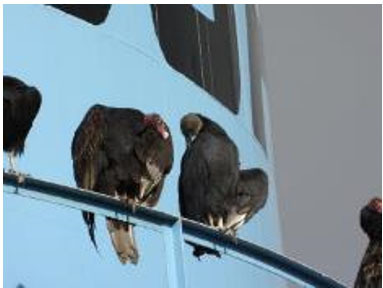
Marian Wahl, a PhD student in the Department of Forestry and Natural Resources at Purdue University, is collaborating with the U.S. Department of Agriculture, Wildlife Services on research to improve understanding of vulture ecology, and to reduce conflicts with people and livestock. Wahl's research seeks to better understand vulture ecology to inform conservation of other vulture species, as well as to understand how best to minimize conflict between vultures and producers by investigating what factors place some farms at greater risk. The first step is to identify vulture roost locations. To do this, Wahl is soliciting roost location reports from anyone who is willing to participate. Roost locations can be any spot where groups of vultures spend time perched, either during the day or overnight, aside from when they are feeding. If you have experience with roost locations and would like to participate, complete the survey here.
There is some potential relief for farmers, because on Oct. 1 the House of Representatives passed the America’s Conservation Enhancement Act (S.3051) which included the Livestock Protection Act. This legislation addresses the deadly and costly black vulture attacks on livestock during calving season and allows farmers to more easily protect their livestock from black vultures.
|

The Indiana Master Naturalist program is sponsored by the Resource Conservation & Development Councils, Indiana Soil & Water Conservation Districts, Purdue Cooperative Extension Service and Indiana Department of Natural Resources. www.indianamasternaturalist.org
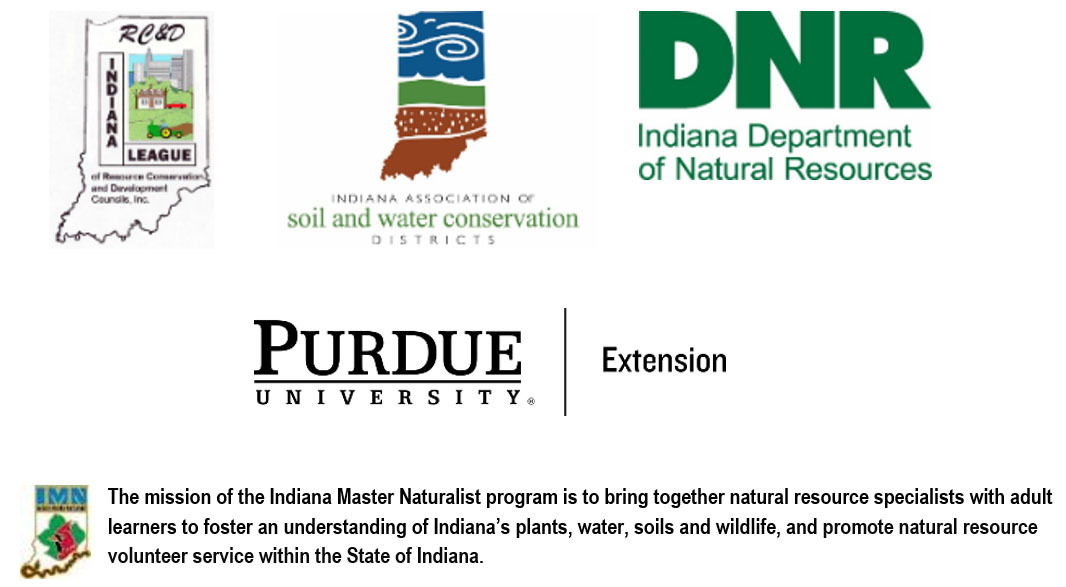
|